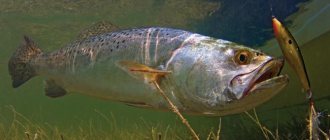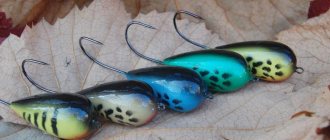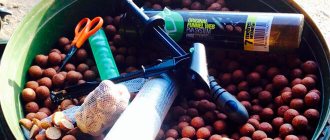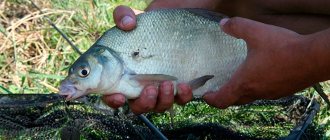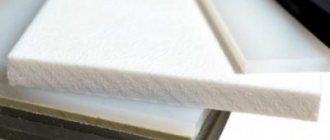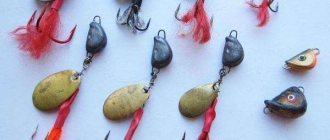The beginning of the fishing season starts with the preparation of reels, fishing rods and, of course, hooks. Oddly enough, but they are no less important elements than other parts of the fishing rod.
The purpose of the hook is to hook the prey. Today the choice of them in the store is simply huge. Sometimes you don’t even know which one to buy or which one is more suitable for this or that fishing.
Many people buy a ready-made version of the device, while others prefer to put their whole soul into it and make it with their own hands.
What is an offset hook
The name “Offset Hook” in translation means offset hook and combines a whole class of single rigs designed for attaching soft-bodied types of bait. The special shape and double bend of the fore-end ensures the strongest possible fixation of baits made of elastic, soft varieties of material, preventing them from slipping off the hook.
Regardless of modification and size, the offset hook consists of two fragments:
- double Z-shaped bend of the front segment of the forend, which is necessary for fixing the end part of the bait.
- a tip that is recessed in the soft plastic of the nozzle or lies on the surface.
In most cases, offset hooks are used in spaced types of rigs, namely the Texas rig with a bullet sinker, the Carolina rig, the lead leash, and the drop shot. The special design of the hook allows the bait to slide with the tip of the sting camouflaged in the body of the bait in the water. Moreover, if you attach a sinker with an “eye” to the hook using a winding ring, you get a hinged mount for jig fishing. Thanks to this installation feature, the mounted bait has mobility, creating its own dynamic “game”, thereby attracting the attention of large predatory fish.
The undoubted advantage of using “offsets” is to ensure that the bait is fixed in a non-snacking version. The downside is that soft silicone or rubber can tear at the puncture sites, slip or even fly off when sharply casting the rod over long distances.
Classic jig with offset hook
Most of my fishing trips take place in the upper reaches of the Cheboksary Reservoir. The most popular among local (Nizhny Novgorod) spinning anglers was, is and remains classic jig fishing. The “jigging wave” that covered our region ten years ago, although it has subsided, still firmly holds its leadership position. I would like to believe that with the current ban on trolling, former trollers will join the ranks of jig fishermen - in general, they are pretty good at catching predators along the edges.
Of the 122 Nizhny Novgorod residents surveyed, exactly half most often use a twister as bait (vibrohost - 40 people, foam rubber - 14, other baits - 7). And a fairly significant percentage of twister fishing fans mount it on an offset hook. This is explained not least by the fishing conditions on our rivers.
Vetluga, for example, and to a somewhat lesser extent Oka and Sura in our area are decently snarled, but there is nothing to say about the upper reaches of Cheboksary - in other places, except for a twister on an offset or a foam rubber with double bayonets pressed to the body, it is impossible to carry out anything.
The offset can (and should) be hidden in the body of the twister in such a way that only the tip of the hook remains at the top. It is rightly believed that non-catching bait installation reduces the number of effective hooks. However, I dare to assure you that this applies to a much greater extent to small fish - pipe cleaners, pike perches, perches - those that are not able to swallow the bait completely. Pike and zander over a kilogram are caught with a decent-sized offset hook very well, and sit better than on a double hook, so the chance of delivering the trophy to the boat increases. So we started talking about sizes.
If we set the goal here of some kind of versatility, then for pike I’ll focus on the set: “round?” offset hook Cannelle No. 3 / 0 with twister Action Plastics 3 FG - cheap and cheerful. In addition to the size of the offset hook, I deliberately indicate the manufacturer. Because with the same markings, offset hooks from different companies can be very different. And if, for example, our twister fits perfectly on Cannelle No. 3/0, then on Saikyo of the same number, for example, the rubber will stretch and slide (see photo above).
Of course, I’m not saying that one offset hook is good and the other is bad, no - it’s just that for the second one you will need to find a different, slightly larger rubber. More about size, now from the point of view of the fish. For a pike, even a relatively small one - weighing a kilogram or a little more - to “eat”? the above tires are no problem.
In the hot summer during the ?brovochnaya? To catch a predator, I would reduce the size of the twister and, as a result, the offset hook, but only in order to increase the number of bites from bersha, pike perch and perch - for pike 3 FG will be “all seasonal?” size, equally good at catching toothy fish in spring, summer and late autumn.
Features of choosing a hook (what to look for when choosing)
When choosing offset hooks for fishing, you need to pay attention to the configuration, size, point of the hook, the diameter of the ring, and the thickness of the material used to make them. It is worth noting that hooks from the same manufacturers with the same number may have different sizes.
Form
Offset hooks, taking into account their shape, are classified into:
- The classic options are the Texas Hook, in which the forend has a straight bend.
- Offset hook Wide Gap. This option is presented with a wider bend, thereby creating a greater distance between the bait and the fore-end when securing it.
- The Sickle Hook has a crescent-shaped bend configuration.
- Options with lead weights on the forend. They are used without additional loads, so they are not intended for casting a fishing rod over long distances.
Classic varieties of offset hooks are used for narrow-bodied baits, for example, twisters, silicone worms, vibrotails that have a groove to mask the tip of the sting. In addition, this type of offset press is used for Texas equipment.
Wide Gap , thanks to the wide gap between the bait and the fore-end, acts on the principle of a lever, so when hooking, the fish presses the hook with its jaws with greater force, thereby increasing the likelihood of hooking. This type of “offset” is ideal when using narrow-bodied, hard bait options or lures with a high body.
It is worth noting that the Wide Gap offset hook is available in two varieties, which differ in different body heights. For baits with a high body position, it is preferable to use hooks in which the direction of the sting is located above the ring.
Offset Sickle Hooks can be considered new on the fishing market. The crescent shape of the curve provides optimal grip and fixation of the bait, making this model ideal for long-distance casting of heavy equipment. When biting, the hook automatically hooks the fish and prevents it from falling into the water when fishing.
Dimensions
The size of the offsets should be selected based on the type of bait used. You need to take into account the length, width, type of bait. The length of the hook should not prevent the bait from “playing” in the water to attract fish. Too long hooks can stretch the twister like chewing gum and reduce the “mobility” of the vibrotail in the water. The height of the bend must be no less than the height of the body of the nozzle. Otherwise, you will have to thread the sting through the body of the bait and bring it out, thereby reducing the non-catching of the equipment.
Material
To produce high-quality offset hooks, carbon and stainless steel are used. To reduce the harmful effects of the aquatic environment and prevent corrosion, protective coatings and compounds are used. “Offset machines” are bronzed, nickel-plated, coated with titanium nitride.
Manufacturers
When choosing offset hooks, in addition to their quality characteristics, it would be useful to pay attention to the manufacturer, taking into account the price-quality ratio. Offset machines of the highest quality: Eagle Claw, Mustad, Owner, Decoy, Crazy Fish Joint Hook, Kosadaka Jaxon. You should not purchase products that are too low in price due to their dubious quality.
Table of offset hook sizes and their ratios
If you know the numbering of offset hooks that are needed for fishing, you can purchase products from different companies, regardless of the country of manufacture. A convenient table makes it possible to find out the numerical designations in different numbering systems .
| International (English) classification | Domestic (former Soviet) numbering | Japanese system | Finnish numbering |
| 24 | – | 26 | – |
| 22 | – | 24 | – |
| 20 | – | 22 | – |
| 19 | 2 | 21 | 22 |
| 18 | 2,5 | 20 | 20 |
| 17 | 3 | 19 | 18 |
| 16 | – | 18 | – |
| 15 | 3,5 | 17 | 16 |
| 14 | – | 16 | – |
| 13 | 4 | 15 | 14 |
| 12 | – | 14 | – |
| 11 | 4,5 | 13 | – |
| 10 | 5 | 12 | 12 |
| 9 | – | 11 | – |
| 8 | 6 | 10 | 10 |
| 7 | – | 9 | – |
| 6 | 7 | 8 | 8 |
| 5 | 7,5 | 7 | – |
| 4 | 8 | 6 | 6 |
| 3 | 8,5 | 5 | – |
| 2 | 9 | 4 | 4 |
| – | 11 | – | 1 |
| – | 12 | – | 1/0 |
| – | 14 | – | 2/0 |
| – | 16 | – | 3/0 |
The size table for offset hooks is easy to use : for example, No. 6 in the domestic classification will correspond to number 10 in the Japanese and Finnish systems, as well as number 8 in the international (English) classification.
When converting a size to another classification, it is important to be sure that the manufacturer has correctly indicated the dimensions of the offset hooks. If similar products have already been used during fishing, you can measure them, and only after that choose the appropriate size in any of the classifications .
It is important to note that in the CIS the former Soviet numbering of offset hooks is more common, in Europe the international (English) classification is popular, and manufacturers in the Land of the Rising Sun create products according to the Japanese system. If a company produces hooks for export, they can also be classified according to international classification.
How to properly place bait on a hook
A special modification of offset hooks allows you to mount the bait as a non-hooking type. When setting the bait, you need to take into account the type of offset. There are two varieties of non-snagging baits: the classic, traditional Texas style; open.
For the first option, you will need a classic offset press with a bend located at a right angle. Initially, the bait is pierced in the end part and fixed on a Z-shaped step. The tip of the sting penetrates the body of the bait completely, but should not come out much. This method ensures maximum fixation of the bait on the hook, preventing snags.
You always need to monitor the level of sharpness of the hook tip so that the tip of the hook not only easily pierces the bait, but is also able to detect the fish during hooking. Texas equipment is used for spaced types of equipment, which fishermen can successfully use when catching pike perch, perch, bream and other predatory fish using a spinning rod.
If you want to find out what gear pike perch bites best with, you can read our article.
In the open method, wide gap offset printers are used. The bait fits tightly to the surface of the bait or is camouflaged in a special groove. A tightly pressed ring does not catch algae or any other aquatic vegetation.
In classic jig fishing, a hook with a “eared” weight is attached using a winding ring. If the eye of the “offset machine” is smaller and does not allow the ring to pass through, you need to bite off a third of the turn from the ring using pliers or side cutters.
In models with lead loading, in which a certain amount of lead is soldered to the fore-end, they are used for soft jerkbaits and swimbaits.
This model of hooks does not require additional shipping and is suitable for spot fishing in dense algae, grass, reeds, that is, in places where there is no need to use long casting.
As already noted, the tip should fit as tightly as possible to the nozzle, otherwise the hook will catch the hook. You don't want to sink the bait too deep into the bait's body. When biting, the bait may not be released and may not hook the fish. Let's look at how to properly attach a vibrating tail to an offset press.
- Pierce the end (head part) of the bait with a sting 0.5-0.8 mm deep, carefully bringing it out through the belly of the bait so that only a small part of it is visible from the body of the bait.
- It is necessary to attach the hook to the back of the vibrotail in order to accurately determine the puncture site and the correct angle at which the hook should enter the body of the bait being used.
- Place the hook at the intended angle.
- If you pierce the body of the bait without selecting the correct angle of insertion of the tip, you may lose the bite when biting.
- Pierce the belly and remove the sting from the back of the bait.
- Check the fixation of the bait.
- To prevent the soft attachments from slipping, they must be slightly tightened during installation.
- If the tip cuts into the bait or is slightly shifted to the side, then the bait is set incorrectly, at the wrong angle.
Installation of silicone baits on a retractable leash.
This is a fairly simple, universal method.
Sinker - any shape will do, but “Drop” would be better;
1. Tie a sinker to the end of the main line using any knot you know. You can watch a video about what they are and how they are knitted on our YouTube channel
2. Tie a leash 20 cm above the sinker.
3. Attach a hook to the end of the leash.
4. Place a silicone bait on the hook.
Advantages: equipping silicone baits with a retractable leash is good because it allows the bait to move smoothly and slowly sink to the bottom. This attracts passive and uncertain fish and pushes them to bite. In addition, this method allows you to cast long distances and fish in reservoirs with strong currents using heavier loads, which will not affect the quality of play of bait of any size.
Helpful Hints: The diverter leash can, if necessary, be upgraded for difficult conditions. If there is a passive fish in the reservoir, then it is better to lengthen it.
If the pond is too snaggy, then use an offset hook, so the bait will cling less often and better avoid obstacles when retrieving.
If you hunt pike, then for better results use a “double”. It will minimize the number of fish hatches and provide you with a good trophy.
In addition to the two main ways to rig silicone baits with an offset hook, there are the following techniques:
1. Drop shot. Simple, easy-to-catch equipment, suitable for any type of silicone bait. It works best when fishing from a boat, vertically, as well as on reservoirs with a rocky bottom. Provides fewer snags as the hook is fixed and located above the load.
The sinker is stick-shaped or pear-shaped;
1. Tie the hook to the fishing line so that it is perpendicular. The tip should be pointing upward. The Palomar knot will help here.
2. Attach a sinker to the end of the fishing line. The distance from the sinker to the hook should be approximately 15-20 cm.
3. Place the bait on the hook.
Advantages: The bait on such equipment is well controlled, since any bite is immediately transmitted to the rod.
2. Jig-rig. Equipment originally developed for catching overseas bass. But it turned out to be quite applicable for domestic pike perch, perch or pike. Similar to a drop shot, but here the load is secured independently. You can unfasten and change the weight, adjusting it to the conditions of the reservoir.
1. A cord, a silicone bait on an offset hook and a sinker on a swivel are attached to the central winding ring.
2. Instead of a central winding ring, a leash with a carabiner attached to a cord is used, onto which a hook with silicone and a weight on a swivel are placed.
[THERE IS AN ANSWER] How to choose an offset hook for a silicone bait?
Advantages: it is universal and can be used with any type of silicone baits, and when using an offset hook, the permeability will improve.
3. Texas rig. Great for fishing in places with a lot of vegetation, snags and various obstacles on the bottom. The equipment is almost not afraid of branches, stones, or algae and bypasses them better than other types.
1. Thread a stopper and a weight onto the main line so that the pointed part “looks” towards the rod.
2. Put on a silicone shock absorber or bead.
3. Tie the hook to the fishing line.
4. Place the silicone bait on the hook.
Advantages: effective when fishing in hard-to-reach places; the shape of the sinker and bait allows it to bypass obstacles and almost not cling to grass or tree branches under water. It is universal and can be used with any type of silicone baits.
Features: you can increase the distance from the weight to the bait, which allows you to work more freely when falling and look more appetizing to the fish.
It will be most effective with an offset hook.
4. Carolina rig. This is a variant of the modernized Texas one. It differs in that a swivel is attached after the weight and stopper. This allows you to replace only the leash with another one if necessary or in case of a break, rather than re-tying the entire rig.
That's all! It is very easy to put silicone on the offset hook! A few training sessions and you'll be making these types of rigs in a matter of seconds.
The offset hook has taken root firmly among spinning fishermen. Modern jig is unthinkable without it. The peculiarity of this hook is its special shape. When equipped with a silicone bait, the tip of the hook is pressed against the back of the bait, which ensures excellent passage through various underwater obstacles.
Hooks of this type are indispensable when fishing in areas with snags, grass, bottom debris, and stones. Each offset hook model is designed for one or another silicone bait. The deeper you pry the offset, the more voluminous the bait can be equipped. Hooks with this hook have the Wide Gape prefix. For worms and slugs, it is customary to use more elongated models with a low hook. In the catalog of many manufacturers you can find options with loading, springs, swivels for drop shots and others.
It is necessary to choose an offset hook in such a way that the sting comes out approximately in the middle part of the bait. If you are tormented by idle bites “by the tail,” you can increase the length of the hook.
Installation of the non-hook paired with this hook is very simple and easy to assemble. The best way to rig a bait:
- Choose the hook size you need
- Place the hook against the bait and remember where it should come out from.
- Pierce the head part of the bait and remove the sting (you need to pierce quite a bit, with a slight slope)
- Pass the bait through the entire hook, unfold it and place it on the step (the part between the shank and the eye)
- Let's see where the hook will come out
- We pierce and remove the sting into the dorsal part
That's all! It is very easy to put silicone on the offset hook! A few training sessions and you'll be making these types of rigs in a matter of seconds.
In more detail, you can watch the video from the author Fishing with SIBIRYAK'007
This soft bait design can be used:
How to properly attach a twister to an offset hook
A twister is a type of artificial fishing bait ranging in size from 1 to 30 cm, which, unlike a vibrotail, is not much like a fish in its shape. Made from soft plastic, silicone, and other polymer materials. Most often used for catching predatory fish species. Let's look at how to attach a twister to an offset press correctly.
- You need to start threading the “offset” from the central part of the bait to a distance that will be in total equal to the length of the step and link.
- We pull the hook through the twister to the step, after which we pull the extension link and the step into the bait.
- It is necessary to turn the hook in the direction of the dorsal part of the bait and approximately estimate in which part of the twister the tip of the equipment should be brought out.
- The point of the hook needs to be brought out near the tail of the bait.
- Using the winding ring, we fix the sinker with the eye.
- We check the reliability of fixing the bait.
How to attach the offset machine to the fishing line
To firmly connect the hook to the fishing line, it is preferable to use a regular “palomar” knot, in which it will be attached to the fishing line in a horizontal position, or a “clinch” knot.
Palomar knot
- To fix the hook on the fishing line with a palomar knot, fold the fishing line in half and thread it into the eye of the rig.
- Tie a regular, simple knot.
- Place the folded end of the fishing line behind the hook.
- Tighten the knot without using much force or sudden movements, so as not to break the fishing line. For convenience, you can first wet the fishing line in water.
- Cut off the excess part of the fishing line with scissors and check the strength of the hook.
Clinch fishing knot
- Pass the line through the hole in the eye of the hook.
- Wrap the hook around the fishing line several times (3-6).
- Place the end of the fishing line through the loop formed near the eye.
- Tighten the assembly carefully, avoiding sudden jerks.
- Cut off the excess piece of fishing line with wire cutters or scissors.
How to tie an offset hook?
The resulting offset hook rig can be tied directly to the main cord, fastened with a clasp, or attached to a metal leash. The offset can be attached to the fishing line using Palomar or Clinch knots. The first one is done like this:
- The fishing line or cord is folded in half and threaded through the eye of the offset hook.
- A simple single or double knot is tied.
- Then the offset with bait is threaded into the free loop.
- The knot is tightened and the excess thread is cut off.
The clinch is no less reliable than Palomar. How to do it is described below in brief instructions:
- The free end of the cord is threaded into the offset eyelet.
- We keep a small loop near the eye and make about five to seven turns around the fishing line.
- We put the free end of the thread into a loop.
- Carefully tighten the resulting knot.
That's it, the offset hook is attached, all that remains is to cut off the extra piece of fishing line.
In the case of using a fastener or a metal leash with twisting, nothing changes. You must first tie them to the main fishing line, and then put on the bait mounted on the offset machine. All that remains is to throw the equipment into the water and catch some predatory representative of the ichthyofauna.
You will be interested in: how to properly tie a leash to a fishing line.
Self-production of offset hooks
If you have the desire, you can make any version of the offset hook yourself.
- It is necessary to purchase regular, high-quality single fishing hooks with a long shank.
- Since the hooks are hardened, in order not to break them, you need to hold them over a small flame of fire, heating the metal of the hook tip with a lighter, a candle or using a blowtorch.
- When fixing the tip with pliers, you need to anneal only a small part of it, the very tip, adjusting the flame level.
- After the hook has cooled, you can begin to bend the step, smoothly bending the tip up and down.
- Thus, you can make a step of the desired configuration, taking into account the type of baits used. It is best to make several types of offset presses at the same time.
Blitz tips
- For catching predatory fish species, offset hooks with numbers No. 3/0, 4/0, 5/0 are suitable.
- For catching pike-perch and perch, it is best to choose thin “offsets” that will ensure free penetration into the fish’s jaws and have the ability to unbend on “dead” hooks.
- For catching pike, catfish and other large fish, it is preferable to use equipment made of more durable, hard metals.
- When using a twister as a bait, do not pierce the body of the bait.
- When choosing equipment, you must always compare the size of the hook with the bait.
Tips for choosing offset hooks
It is important for a novice spinning fisherman to understand how to choose an offset hook, what to look for, their main characteristics and parameters. The most important indicators of these specialized singles are:
- size;
- form;
- material;
- manufacturer.
The sizes of offset hooks are usually divided by numbers. Offset hooks with the designation “6/0”, “5/0”, “4/0” and so on are large hooks designed for large bulky baits and weighty fish. Single rods marked “6”, “8”, “10” are intended for ultralight, microjig, fishing for white predator and perch.
Advice! Each manufacturer's size range of hooks may differ, but the principle of indicating their length remains the same. The dimensions of offset hooks in centimeters, as a rule, are not indicated.
The shape of offset hooks can be different and are intended for diverse tasks, fishing methods and types of silicone baits. The most common are:
- Classic with straight bend. Used in Texas rigs, Carolina rigs, and jig rigs.
- With a wide bend. It's called "WideGap". This is an offset hook for vibrating tail and other fleshy, bulky baits. Some spinning anglers call these types of offset hooks for pike.
- With an elongated bend. Suitable for twisters and worms.
- With a crescent-shaped bend. It's called "SickleHook". Designed for weighted mounting of silicone baits and fishing at ultra-long distances.
- Models with a weight rigidly attached to the offset forend. Needed for short fishing at shallow depths. Suitable for fishing shallow water areas with algae and coastal strips.
There are offset hooks with a spring designed to securely fix the bait. This option allows you to extend the life of the “rubber”, since with this installation the head part of the bait does not break so quickly, maintaining a suitable appearance for a long time.
All offset machines are made of stainless steel. This material has sufficient strength, rigidity and reliability. Depending on the purpose, it can be subject to various heat treatments, which impart the necessary properties to the product. At the finish, single strips are sprayed. They can be plated with nickel, anodized aluminum, or bronze. The best offset hooks are treated with titanium nitride.
Among the manufacturers of offset hooks there are famous brands known to all fishermen. These are Decoy, Owner, Gamakatsu, VMC. There are products that are cheaper, but of acceptable quality - Mustad, Hayabusa, Select, DAM and others.
How to choose an offset hook for a silicone bait? What should you pay attention to initially? — This is the size of a single. You need to understand how to choose an offset according to the size of the bait. To do this, you need to attach it to the “rubber”. The length of the hook should be approximately equal to 2/3 of the length of the silicone, and the sting should come out in the middle of the bait.

